Walker Evans
 Walker Evans
Walker Evans (1903-1975) is considered the best American documentary photographer of the twentieth century. His photographs of sharecroppers in Depression-era Alabama appeared in the book, Let Us Now Praise Famous Men, published in 1941 with text by writer and journalist James Agee. Although he spent only a few weeks of his life in the state, his Alabama photos represent Evans’s most famous and perhaps finest work. Evans’s Alabama photographs have become iconic images of the Great Depression era and gave a personal face to an overlooked segment of American society.
Walker Evans
Walker Evans (1903-1975) is considered the best American documentary photographer of the twentieth century. His photographs of sharecroppers in Depression-era Alabama appeared in the book, Let Us Now Praise Famous Men, published in 1941 with text by writer and journalist James Agee. Although he spent only a few weeks of his life in the state, his Alabama photos represent Evans’s most famous and perhaps finest work. Evans’s Alabama photographs have become iconic images of the Great Depression era and gave a personal face to an overlooked segment of American society.
Walker Evans was born in Saint Louis, Missouri, on November 3, 1903, to Walker (an advertising director) and Jesse Crane Evans. The family moved to several cities while Walker was a child. In 1922, he graduated from Phillips Academy in Andover, Massachusetts. Evans briefly attended Williams College in Massachusetts before moving to New York City to work various odd jobs. In 1926, Evans moved to Paris and occasionally audited classes at the Sorbonne. As an American expatriate in Paris, Evans pursued a writing career but doubted his ability to achieve the high literary standards he set for himself. The relatively new technology of the camera attracted him, and he began experimenting with photography as his medium for artistic expression.
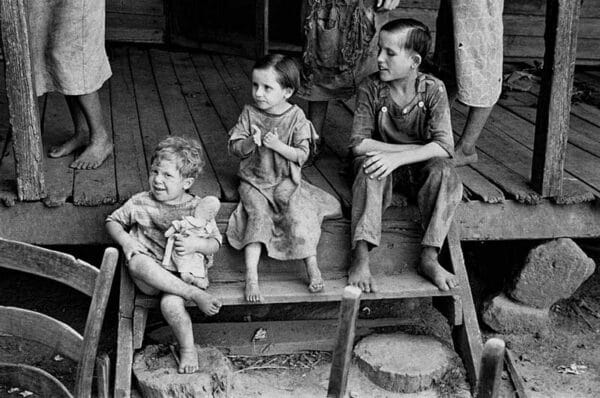 Tengle Children in Hale County
By 1928, Evans was back in New York and working seriously with photography. His first published photographs illustrated a 1930 volume of Hart Crane’s poem “The Bridge.” Evans quickly established a reputation as a photographer and began a series of photographic commissions and exhibitions. In 1935, he commenced work on photographic surveys for the Farm Security Administration (FSA), an agency created as part of Pres. Franklin Roosevelt’s New Deal recovery plan during the Great Depression. Evans was charged with documenting rural and working-class American landscapes and in 1935 began traveling in Pennsylvania, West Virginia, and the southern states. Officially, Evans was there to record documentary pictures of Birmingham’s industrial areas and
Tengle Children in Hale County
By 1928, Evans was back in New York and working seriously with photography. His first published photographs illustrated a 1930 volume of Hart Crane’s poem “The Bridge.” Evans quickly established a reputation as a photographer and began a series of photographic commissions and exhibitions. In 1935, he commenced work on photographic surveys for the Farm Security Administration (FSA), an agency created as part of Pres. Franklin Roosevelt’s New Deal recovery plan during the Great Depression. Evans was charged with documenting rural and working-class American landscapes and in 1935 began traveling in Pennsylvania, West Virginia, and the southern states. Officially, Evans was there to record documentary pictures of Birmingham’s industrial areas and
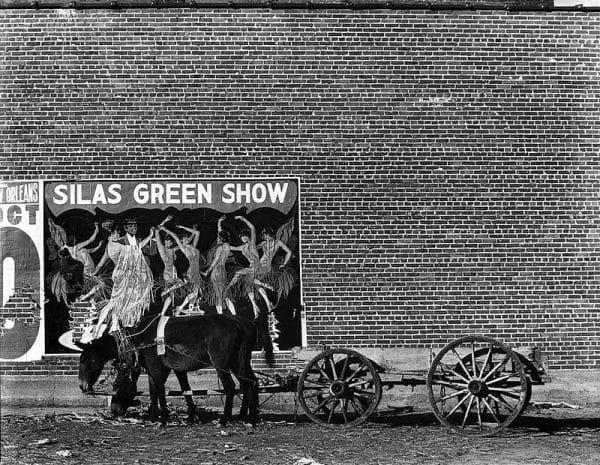 Silas Green Show Poster and Mules
“rural subjects” in other parts of the state, but his interest was often drawn to more whimsical images that did not always follow the FSA mission and mandate. For example, some of his most memorable Alabama photographs from the period include pictures of festive and fading posters for traveling circuses and theatrical troupes.
Silas Green Show Poster and Mules
“rural subjects” in other parts of the state, but his interest was often drawn to more whimsical images that did not always follow the FSA mission and mandate. For example, some of his most memorable Alabama photographs from the period include pictures of festive and fading posters for traveling circuses and theatrical troupes.
In 1936, Fortune magazine asked James Agee to write an article about sharecroppers in the Deep South for its series about American life called “Life and Circumstances.” Agee requested Walker Evans as the project’s photographer. Evans took leave from the FSA and travelled to
 Selma Sidewalk by Walker Evans
Alabama with Agee in the summer of 1936, in search of subjects for the collaboration. Agee and Evans arrived in Hale County, an area of the state that Evans had previously photographed for the FSA. At the Hale County Courthouse in Greensboro, they met three sharecroppers from the nearby community of Mills Hill. That day, Evans began to take some of the most remarkable and praised photographs of his career, and Agee began to gather material for his most challenging and enduring book, Let Us Now Praise Famous Men.
Selma Sidewalk by Walker Evans
Alabama with Agee in the summer of 1936, in search of subjects for the collaboration. Agee and Evans arrived in Hale County, an area of the state that Evans had previously photographed for the FSA. At the Hale County Courthouse in Greensboro, they met three sharecroppers from the nearby community of Mills Hill. That day, Evans began to take some of the most remarkable and praised photographs of his career, and Agee began to gather material for his most challenging and enduring book, Let Us Now Praise Famous Men.
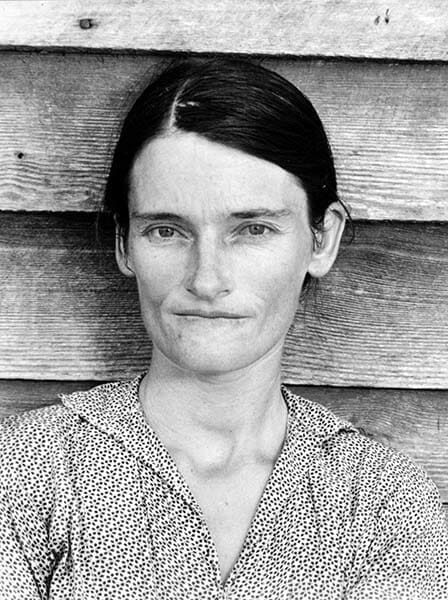 Allie Mae Burroughs
Evans and Agee spent several weeks in Hale County gathering and documenting material about the three families. Agee stayed for a time in the tiny farmhouse of one family, but Evans stayed in a nearby hotel. The black-and-white photographs he took for the Fortune assignment are straightforward and powerful. The portraits are a stark and memorable document of the earnest, proud, and straightfoward farm families of the region. Two of the most commonly reproduced examples, “Floyd Burroughs, Sharecropper, 1936” and “Allie Mae Burroughs, Wife of a Sharecropper, 1936,” present the viewer with an image of forthright dignity.
Allie Mae Burroughs
Evans and Agee spent several weeks in Hale County gathering and documenting material about the three families. Agee stayed for a time in the tiny farmhouse of one family, but Evans stayed in a nearby hotel. The black-and-white photographs he took for the Fortune assignment are straightforward and powerful. The portraits are a stark and memorable document of the earnest, proud, and straightfoward farm families of the region. Two of the most commonly reproduced examples, “Floyd Burroughs, Sharecropper, 1936” and “Allie Mae Burroughs, Wife of a Sharecropper, 1936,” present the viewer with an image of forthright dignity.
Evans’s photographs of the farmhouses themselves achieve an enduring power through their masterful framing and composition. In “Kitchen, Burroughs Home, 1936,” for example, the monotony of the bare plank floors and walls is punctuated by simple necessities: a bowl on a shelf, a plain towel hanging from a nail, a plain wooden table covered with patterned oilcloth, a kerosene lantern, a chair, a pantry with a large churn on its shelf, bright sunlight from an unseen window.
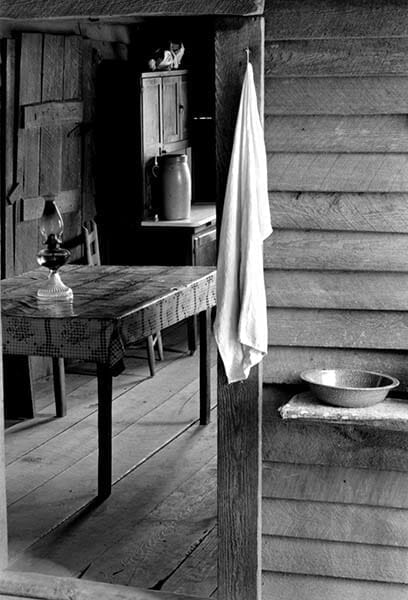 Home of Sharecropper Floyd Burroughs
Fortune never published Agee’s article, but the book, Let Us Now Praise Famous Men, appeared finally in 1941. Agee’s epic text was complemented by a portfolio of 31 of Evans’s photographs. The book, especially the photographs, received respectful reviews, but only 600 copies were sold after the initial publication. However, Evans’s Alabama photographs soon developed a life of their own. In 1938, New York’s Museum of Modern Art mounted an exhibition titled “Walker Evans: American Photographs,” and the Alabama photographs were included in the exhibition and in the show’s catalog.
Home of Sharecropper Floyd Burroughs
Fortune never published Agee’s article, but the book, Let Us Now Praise Famous Men, appeared finally in 1941. Agee’s epic text was complemented by a portfolio of 31 of Evans’s photographs. The book, especially the photographs, received respectful reviews, but only 600 copies were sold after the initial publication. However, Evans’s Alabama photographs soon developed a life of their own. In 1938, New York’s Museum of Modern Art mounted an exhibition titled “Walker Evans: American Photographs,” and the Alabama photographs were included in the exhibition and in the show’s catalog.
Evans left the FSA in 1937. As his reputation increased, he continued to publish photographs, exhibit his work, and receive prestigious grants. He contributed book and other reviews to Time magazine from 1943 to 1945. In 1945, he became a staff photographer and eventually Special Photographic Editor at Fortune. He married Jane Ninas in 1941, but they divorced in 1955.
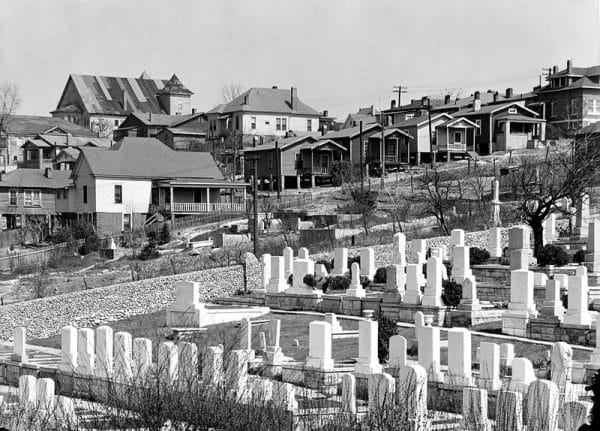 Birmingham, ca. 1936
In 1960, a second edition of Let Us Now Praise Famous Men was published, with an expanded portfolio of 62 Evans images. The re-issue brought Evans’s work to a whole new audience and earned him enthusiastic new appreciation. That same year, Evans married Isabelle Boeschenstein von Steiger. By 1965, he had left Fortune and become a professor of graphic design at Yale University in New Haven, Connecticut. He was internationally regarded as a grand master of American photography. His work and publications continued to gather a wide and appreciative following with each generation. Evans retired from Yale in 1972. His second marriage ended in divorce the following year.
Birmingham, ca. 1936
In 1960, a second edition of Let Us Now Praise Famous Men was published, with an expanded portfolio of 62 Evans images. The re-issue brought Evans’s work to a whole new audience and earned him enthusiastic new appreciation. That same year, Evans married Isabelle Boeschenstein von Steiger. By 1965, he had left Fortune and become a professor of graphic design at Yale University in New Haven, Connecticut. He was internationally regarded as a grand master of American photography. His work and publications continued to gather a wide and appreciative following with each generation. Evans retired from Yale in 1972. His second marriage ended in divorce the following year.
In 1973, Evans returned to Hale County for the first time since 1936. On this brief visit, he travelled with Alabama-born artist William Christenberry, whose own photographic work was greatly influenced by the 1960 re-issue of Let Us Now Praise Famous Men. This time, Evans photographed in color using a simple Polaroid SX-70 camera. Some of the 1973 Alabama photographs by Evans were included in a touring exhibition of the photography of Evans and Christenberry organized by the Amon Carter Museum of Fort Worth, Texas, in 1990. An exhibition catalog, Of Time and Place, was published the same year. Walker Evans suffered a massive stroke and died in New Haven, Connecticut, on April 10, 1975, at age 71. Evans’s images of the state and its people remain an important commentary on life in Depression-era Alabama and on the character of the people who endured it.
Additional Resources
Agee, James and Walker Evans. Let Us Now Praise Famous Men. Boston: Houghton Mifflin, 1941.
Evans, Walker, with an essay by Lincoln Kirstein. American Photographs. New York: Museum of Modern Art, 1938.
Evans, Walker. Walker Evans: First and Last. New York: Harper & Row, 1978.
Evans, Walker, with an introduction by Jerold C. Maddox. Walker Evans: Photographs for the Farm Security Administration, 1935-1938. New York: Da Capo Press, 1973.
Mellow, James R. Walker Evans. New York: Basic Books, 1999.
Southall, Thomas W. Of Time and Place: Walker Evans and William Christenberry. San Francisco: Friends of Photography; and Fort Worth: The Amon Carter Museum, 1990.


